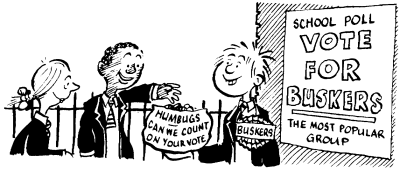| Samples and Polls

Which Is
the Most Popular Group?
In Newtown Lower School there are 1000 pupils. Each pupil was asked to pick a favourite
group from
- Accidentals
- Buskers
- Caterwaul
You will predict the popularity, of each group using samples. The favourite groups are
given in Table 2.
- Use random numbers to choose a sample of 50 pupils from all three years. Using
tally marks, record the number of votes for each group from this random sample in Table 5
on page R1.
- Draw a bar chart to show the number of votes for each group.
You are going to choose a stratified sample of 50 pupils. In Newtown Lower School,
there are 1000 pupils. In the first year. there are 300 pupils. The stratified sample will
contain:
50/1000 x 300 first vear pupils, i.e.
15 pupils.
- There are 400 pupils in the second year and 300 pupils in the third year. How
many second year and how many third year pupils will there he in the stratified sample?
Table 2 - Popular groups at Newtown Lower School.
- Choose the pupils in the stratified sample using random numbers. Record the
number of votes for each group in Table 6 on page R1.
- Complete Table 6 by fmding the total number of votes for each group from the
sample.
- Draw a bar chart to show these results.
- Find the actual number of votes for each group by counting all the results (get
a friend to help you).
- Draw a bar chart to show these results.
- Compare your results and bar charts with a friend's.
Which sample was the more representative?
- Compare your sample results with the complete results. Which sample was the more
representative?
Choose Your
Own Poll
In an opinion poll you should consider the following questions:
- What do you want to find out and why?
This will help exact wording of questions.
- Who might use the information you collect?
This affects what sort of questions to ask.
- Whom will you ask?
You must include all relevant people as possibilities.
- What questions will you ask?
You must phrase questions simply, clearly and concisely. It is useful to test the
questions first.
- How many people will you ask?
If there are not too many you could ask everyone (a census). Larger samples are
generally more accurate. Most samples are in the range 50 to 3000.
- How will you choose your sample?
This is very important. You must choose a fair and representative sample.
- How will you present your results?
You should write a report describing what you did and what you found.
- Choose one of the following surveys. Describe how you would carry it out. Use
the above questions to help you describe what you would do.
- A traffic survey to investigate the number, frequency and type of vehicles using a
particular road near the school.
- A survey of which magazines should be in the school library.
- A survey to find out which foods the school tuck shop ought to sell.
|